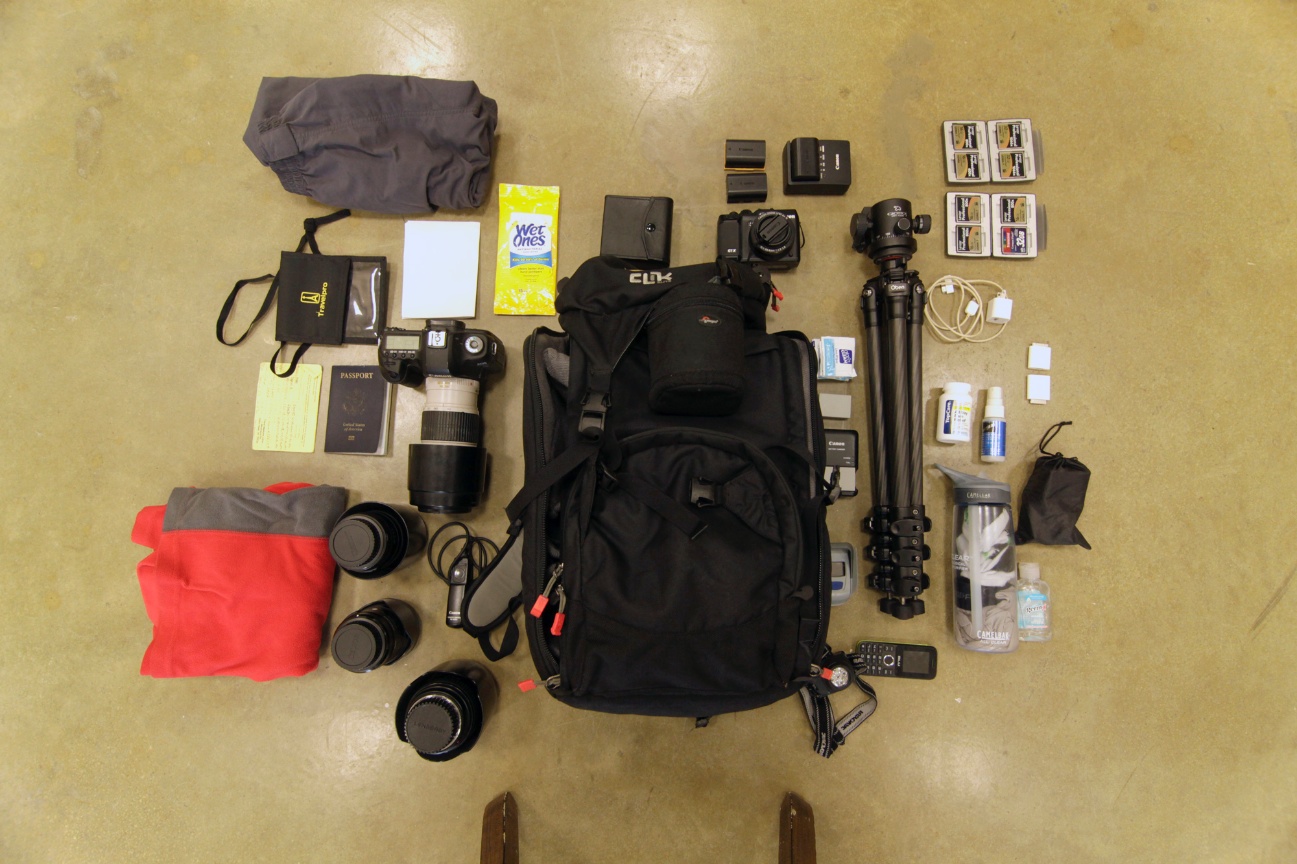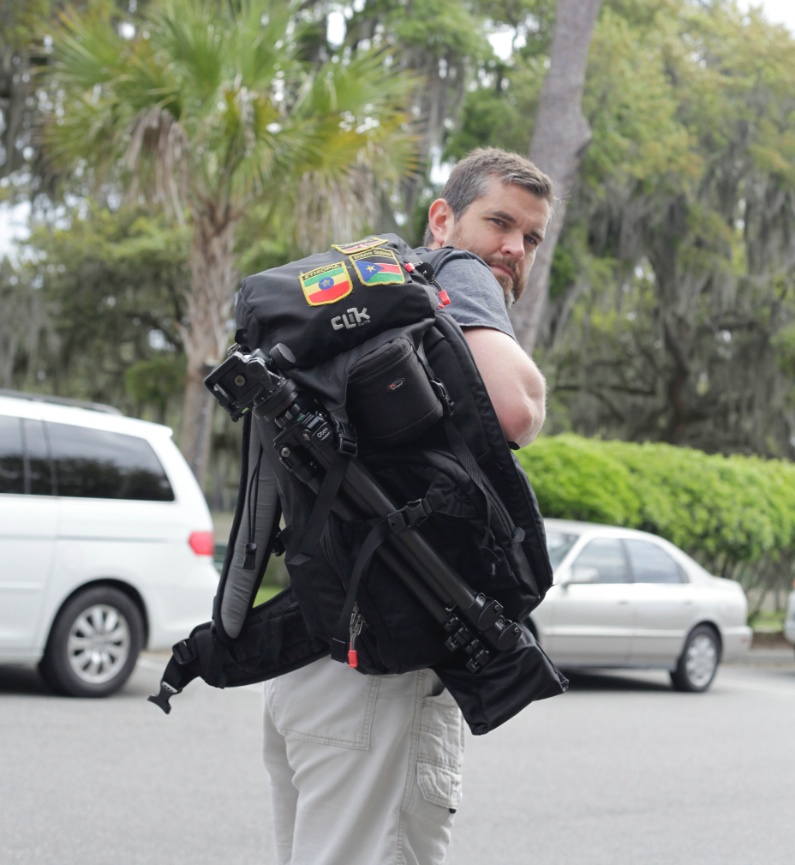Every once in a while I like to give some practical advice to people who might be taking a trip to Africa, particularly those who are going primarily to take pictures. Well, 108 blogs later, I’ve finally decided to do a comprehensive breakdown of how I pack my carry-on bag. I start with the attitude that if the airline loses my check-in bag, I could still continue on with my trip without much inconvenience. As such, I only pack in my check-in bag extra clothing, toiletries, and medication that I can live without should the airline lose them. In fact, I’ve traveled to Africa on a few occasions without actually checking a bag. Traveling light is the key, because the more you have to carry, the more difficulty you will have getting around, and the more you will miss. I travel with a minimal amount of clothing, but mostly stick with synthetic materials and bring a small bottle of detergent so that I can wash clothing by hand every two or three days. Synthetics also dry much faster. The following image shows the contents of my photo backpack laid out. The bag is a Clik Elite. I’ve used other bags in the past and found that for the hard use I give them, they tended to break down to the point that my heavy lenses were all sitting in the bottom of the bag after a long day of walking. (I am not endorsed by Clik Elite.) The Clik Elite bag gets dirty, but it holds up to a beating.
Contents:
1. Canon 5D Mk2 SLR camera. 21 megapixels which is plenty should I need to crop the picture later. It’s been beaten up, gotten wet, been in the dust, and still takes great pictures.
2. 4 lenses. My two primary lenses are a Canon 135 mm f2 for taking tight portraits, and a Sigma 35 mm f 1.4 for taking wider portraits and landscapes. These are my go-to lenses for taking those winning shots. The shallow depth of field I get and the low light capabilities make carrying these totally worth the extra weight of redundant focal length lenses. My two other lenses for more general use are a Canon 24-70 f2.8 and a Canon 70-200 f4 image stabilized lens.
3. Canon G1X Point and shoot camera. It’s small and discreet for when I have to be less conspicuous, but has an APS-C sized sensor inside for much better quality pictures than a typical point and shoot camera. It also shoots 1080p video. The camera does have its limitations though, just due to what it is.
4. Extra batteries for both cameras, as well as chargers.
5. 300 gigabytes of memory cards. At least some need to be fast enough to shoot video.
6. Oben carbon fiber tripod with ball head. This is a must if you’re going to shoot video or time exposures.
7. Camelbak All Clear bottle. This has an ultra-violet lamp built in so I can purify water should I need to. It purifies unsafe water in one minute. I drank water out of the Nile for five days without getting sick using this. I also stuff the bottle with an extra pair of clean socks and undies for traveling. (Use your space to the fullest).
8. Extra pair of pants and a fleece shirt. (It can be quite cold in the parts of Ethiopia I go to.) I also pack extra clothing into any empty spaces in the bag.
9. Ipad 64 gig (not shown). This has reading material, allows my to load pictures and write my blog while away, and has VOIP software for making phone calls when I have wi-fi overseas.
10. Adapters for linking my camera to the iPad.
11. Unlocked GSM world phone. This is a multi-band phone that I can buy a sim-card for when I get to Africa so I can make local calls. I can also call home with it when there’s no internet available but cell phone service is.
12. Passport and yellow fever card. Many countries in Africa require proof you’ve had your yellow fever immunization.
13. Power converter and adapters. Lets you plug in your US based electronics into foreign outlets.
14. Case of photo filters with polarizing filters and Neutral Density filters.
15. Disposable eyeglass wipes for cleaning lenses. Travel is too dirty to reuse a normal lens cleaning cloth.
16. Hand sanitizer.
17. Wet wipes for cleanup when there is no water available or for on the plane. (These are your best friend in Africa.)
18. Remote trigger for camera. Needed for taking long time-exposures or for discreetly triggering your camera.
19. Pain reliever. (I have plantar fasciitis which can hurt after standing all day.)
20. Bug spray. This is a necessity if you are going to areas where malaria is common.
21. Head lamp. Africa is frequently very dark.
22. Cash and credit cards. (Not shown)
What I didn’t bring but could have
1. Anti-malarial drugs. You have to weigh your risks. I’ll only be in an area with malaria for a couple days, so is it worth being on drugs with potential side effects for two days of protection? I decided not to. That’s why I have bug spray. Also, use the mosquito nets at night if you’re in an area with malaria and don’t be outside in the evening.
2. A flash. I’ve brought a flash before, but found that for my style of shooting, out of a couple thousand pictures taken, I used the flash for about 10.
So you might have a hard time believing that all that goes into the bag. I can assure you that it does. It does fit under a the seat in front of you even on a small plane, though I usually have to take the tripod off and place it beside. Weight is almost certainly over the limit, but fortunately most airlines don’t weight your carry-on bag. So here is the bag as it’s packed and ready to go. As a side note, my check-in bag is also a backpack, so that if I have to travel over distances cross country I can put one over each shoulder. Total weight for both bags is somewhere between 50 and 60 pounds.
